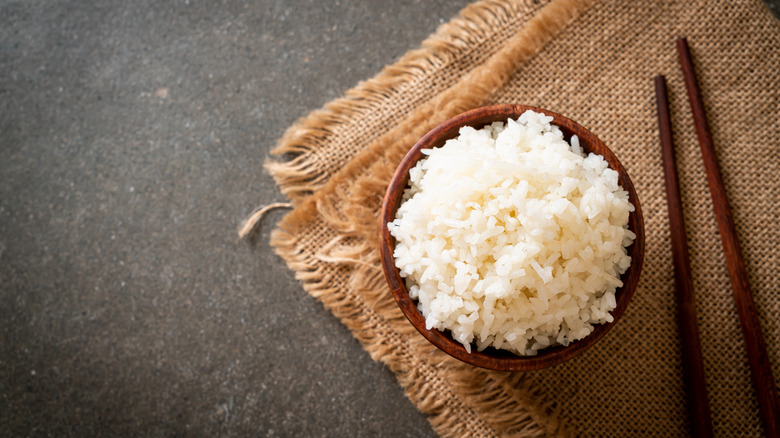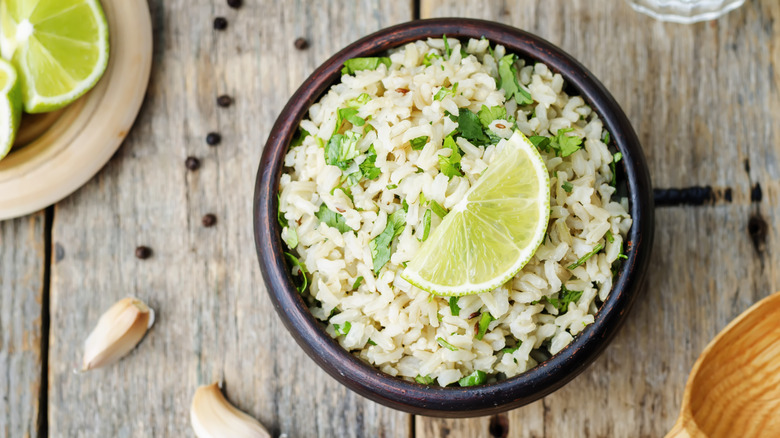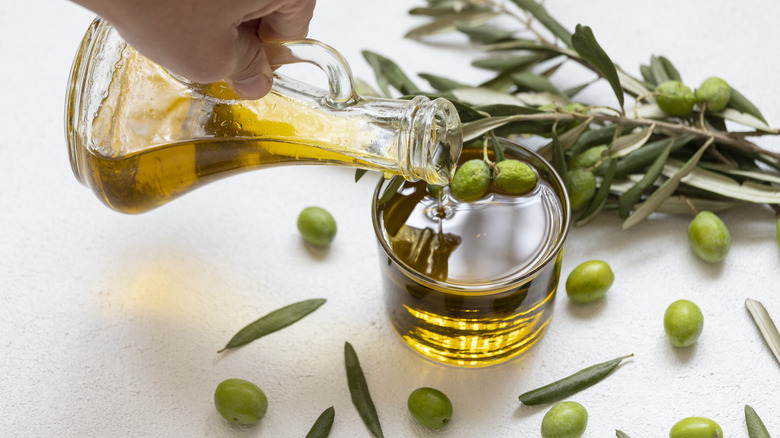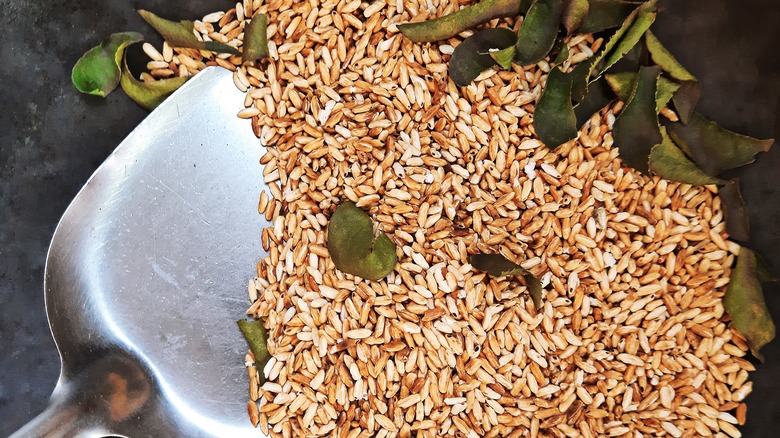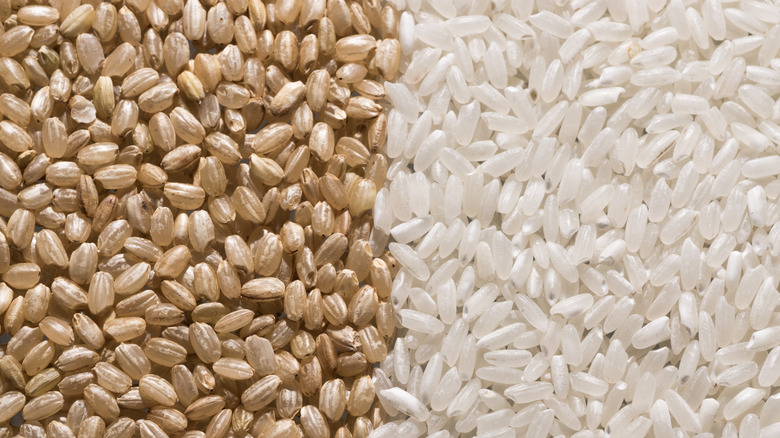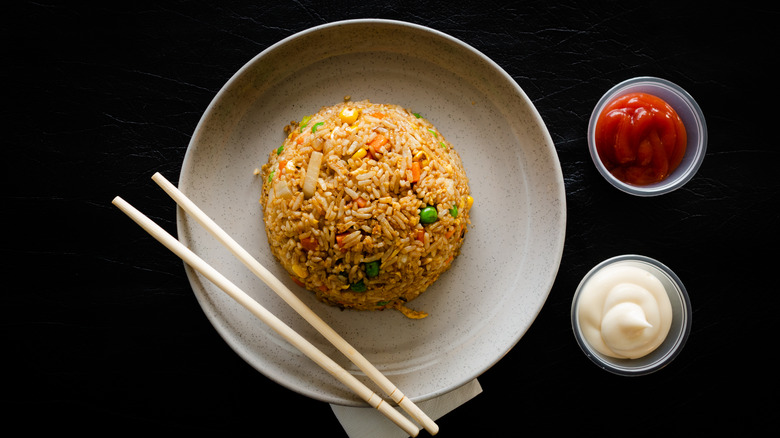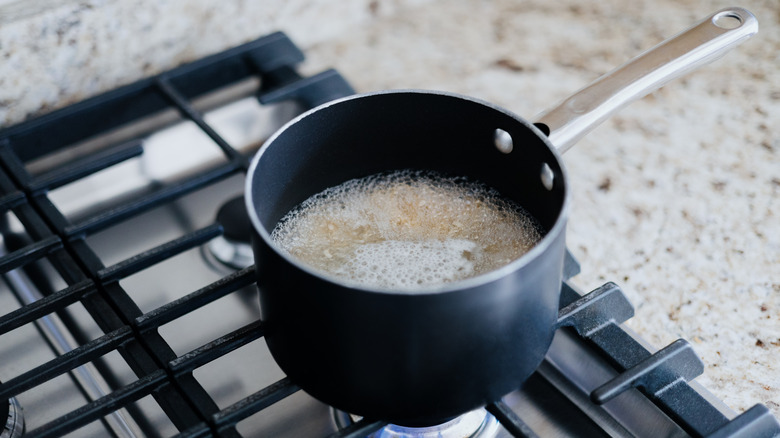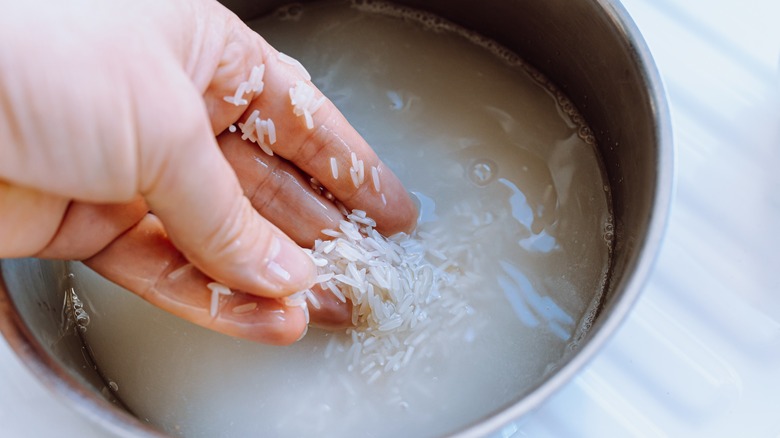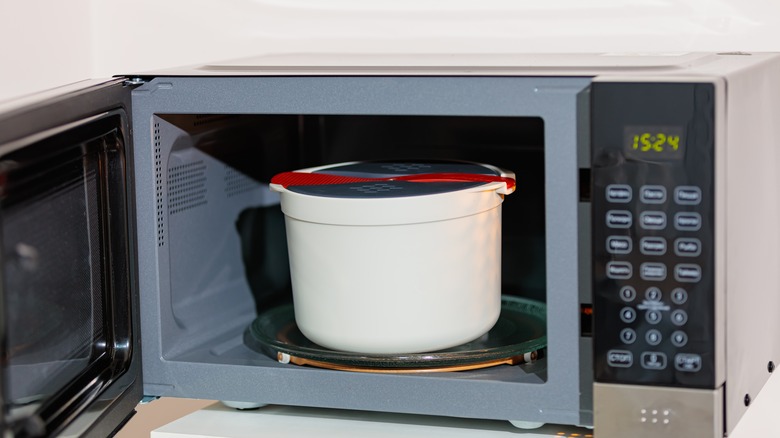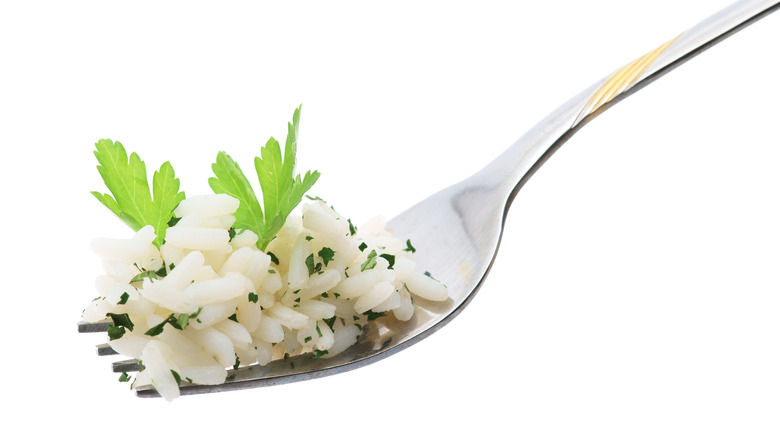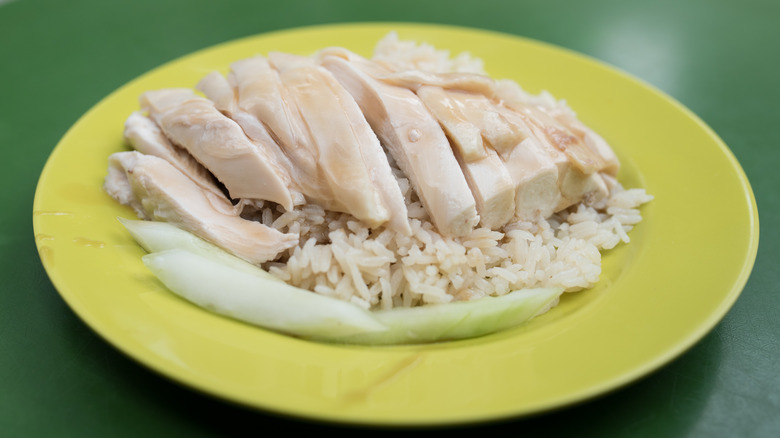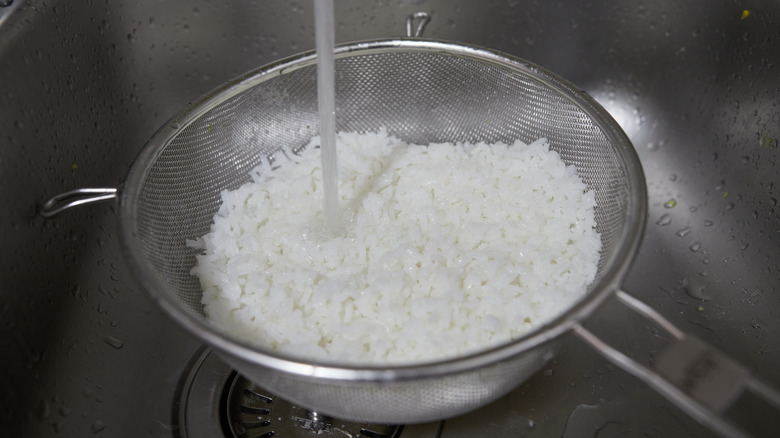The Mistakes Keeping You From Perfect Rice
Cooking rice seems pretty straightforward for most home gourmands, until they end up with a mouth full of crunchy, half-done grains because they haven't cooked the rice long enough. After making a mistake like this, putting out an excellent bowl of rice doesn't appear to be quite so straightforward after all. And given that rice plays a key role in many cuisines, getting it right seems pretty important.
Sometimes, fixing issues with your rice can be as simple as investing in a good rice cooker. However, other challenges require a bit of troubleshooting to ferret out the problem. It's also the case that different problems show themselves at different times of the cooking process. In other words, you might have a handle on cooking rice but have no clue how to season the rice of how to simplify the cooking process without sacrificing quality.
The kind of rice you're working with, whether it's white or brown or even leftover rice, also influences both the cooking process and the outcome of the dish. The more you know about these differences, the better chance you have of have of sidestepping the issues altogether. The most serious of these mistakes mean you scrap your home-cooked dinner and order takeout. In light of that, this post offers a deep dive into the most common mistakes everyone makes when they cook rice and provides practical tips to help you create an amazing bowl of rice every time.
Not seasoning the water
Garlic. Rosemary. Butter and the like. These count among the herbs, spices, and flavorings that people add to steamed rice after it's cooked. However, there's no reason to wait to flavor up steamed rice. Adding herbs and spices to your rice before it's steamed fills the grain with a flavorful infusion, making it tasty right out of the rice cooker. And you aren't limited to herbs and spices. Substituting the liquid in rice is both a simple and tasty way to perk up plain white rice. For example, try beef, chicken, or vegetable stock in place of water. Bullion cubes dropped into your cooking water creates a similar effect.
However, a bit of creativity takes your rice to the next level. For example, borrowing a bit of the flavor profile from your main course makes sense here. For example, add ginger or garlic to rice that'll accompany an Asian stir fry. Your seasoned rice plus a dash of soy sauce, coconut aminos, or tamari added to it post-cooking flavors the rice completely. Or try a pinch of onion powder in rice to complement Italian or Mexican dishes. Such a rice might even be the foundation for a risotto recipe. Long-grained rice, like jasmine or basmati, typically works better as a pre-seasoned rice. As far as the amount of seasoning you'll need, it'll vary, though a quarter to a half teaspoon is pretty typical in a seasoned rice recipe.
Forgetting the olive oil
Olive oil improves just about any dish, including plain steamed rice. Drizzling a bit of it into your rice cooker boost the flavor of the rice, creating hints of nuttiness to its flavor profile. Olive oil also stops the rice from sticking together and bolsters the moisture levels and the texture in the rice. It's a popular oil to combine with seasonings, like garlic, in seasoned rice dishes.
In this case, a little olive oil goes a long way. It's a half teaspoon of olive oil to a half cup of rice ratio. A dash of salt in the water flavors it even further, though this can be left out if you're eating a low-sodium diet. The mixture needs to cook for about 20 minutes in the rice cooker and then sit for another five minutes before you serve it. In short, olive oil is a simple way to add flavor and change the texture of your rice without requiring you to fully season it as you would with seasoned rice.
Not browning the rice in a pan before steaming it
Despite seeming logic, the first step to making steamed rice isn't putting the uncooked rice into the steamer. Or, at least, it shouldn't be. Instead, the savvy rice maker will pour a bit of oil into a wok or skillet, add in the rice, and brown it for five to seven minutes. And the even savvier cook tosses some chopped onions or minced garlic in the pan for the rice to swirl around in. Only then is the rice fit to go into the rice cooker or in a pan on the stove.
Browning the rice before cooking brings a hint of nutty flavor to the rice that carries over to the finished product. Once it's browned, the treated rice goes into your rice cooker (or stockpot if you're making a soup with rice). To ensure that the rice is of high quality, be sure to rinse it before you brown it in the skillet to rid it of any debris or dust that can negatively affect the flavor of the rice. Browned rice works nicely with dishes like a salmon poke bowl, roasted vegetables, or fried rice dishes.
Cooking brown and white rice the same way
Most rice eaters know brown and white rice differ from each other, and nowhere is this more apparent than when you try to cook the two types of rice in exactly the same way. The chasm between the cooking methods comes down to the hull that still clings to brown rice.
Brown rice is a whole grain that includes a fiber-rich outer shell. It's this brown coating that makes the rice chewier and nuttier in flavor than its white counterpart. The extra coating is also the reason why you need to cook brown rice for a longer amount of time than white rice. It also requires more water to cook, too.
There's a formula to cooking white rice — the one, two, three method — that doesn't apply to brown rice. This method means that one cup of uncooked rice needs to cook in two cups of water and will produce three cups of cooked rice. Instead, brown rice requires about two-and-a-half cups of water for the same amount of rice and 45 to 55 minutes of stove time. (White rice will take about 30 minutes, give or take.) In light of this, it probably goes without saying that you can't cook these two types of rice at the same time, even if you might feel inclined to put them in the same dish. Cook them differently and separately for best results.
Not allowing rice to cool before making fried rice
If you're making fried rice at home, it can be tempting to take the steamed rice straight out of the rice cooker and toss it into the wok when you're ready to make fried rice. However, patience pays when it comes to making fried rice. In spite of being a bit counterintuitive, the most unforgettable fried rice doesn't come from freshly steamed rice. Rather, you'll get better rice if you chill it and allow it to dry out a bit. It clumps less if you give it some breathing room. The process is called retrogradation, which means that soft rice recrystallizes once it's allowed to cool. That's why it's less lumpy.
There is a caveat to this. It's not that you can never use freshly steamed rice to make fried rice. However, if you do, you'll want to take some steps to air it out a bit. Spreading it out over a baking sheet for some time allows the excess moisture to evaporate. Putting a fan over the baking sheet helps, too. Or you can save yourself some time and energy and just tuck a bit of your steamed rice away the next time you make it and turn it into fried rice after it has been sitting in the fridge over night. If you do this on the regular when you make steamed rice, you'll start to look at rice leftovers from a whole new perspective.
Not rubbing down your rice mold with broth
Perfectly-shaped domes of fried or steamed rice aren't just the stuff of local Chinese restaurants. You can make them at home if you know this handy trick. To try it, you'll need a small, round soup bowl and a bit of fatty broth. (If you've boiled chicken or beef, the broth can come from that pot.)
Dip a corner of a paper towel into the fatty broth and rub the paper towel around the inside of the bowl. Next, fill the bowl with rice and flatten the rice with a spatula to make the top perfectly smooth and even with the lip of the bowl. Place a plate on top of the bowl's opening, flip the bowl of rice and the plate upside down, and slide the rice out of the bowl and onto the plate. The fatty broth helps to prevent the rice from sticking to the bowl, leaving you with a dome of rice. Add a bit of the broth to the top of the rice, too, if you want some additional flavor.
Only using your rice cooker to cook rice
While rice cookers certainly make whipping up a batch of steamed rice quick and easy, they're not the only game in town when it comes to making rice. A pot, some water, and a stove stand in nicely if you find yourself down a rice cooker. However, to be fair, you'll approach cooking rice in a stove-bound pot a bit differently than you might expect. Instead of trying to turn it into a makeshift rice cooker, treat the pot and the rice like you're cooking pasta.
Fill the pot with the rice and enough water to boil the rice in and allow it to bubble and jump actively in the pot, just as pasta does in boiling water. You're not going for the big block of steamed rice you'd get from steaming rice in a rice cooker. Instead, it'll become loose and fluffy as it boils. Cooking times vary, but a good rule of thumb is to leave it in the pot for three to five minutes less than you'd keep it in the rice cooker, checking on it for doneness occasionally. You can cover it with the lid, but remember to stir it occasionally so that it doesn't stick to the pot.
Once it reaches the desired consistency, pour it into a colander over the sink, letting it sit for a few to really drain. Fluff it up with a fork, season it, and serve it up as you normally would.
Starting with unwashed rice
It is unlikely that you envision rocks, teeny beetles, lots of dust, and some plant oils in your bag of rice when you pull it from the store shelves, but any and all of those items may turn up in a standard bag of rice. If ever you've skipped rinsing your rice before cooking it, you may now understand why it's such a good idea to do so. Dirt plus rice oils equals yuck.
Typically, rice needs to be rinsed under a running faucet for a couple of minutes. It should go into a bowl or the pot you'll cook it in and flooded with water. The water will turn cloudy as you wash the rice in the bowl or pot. Dump the dirty water at regular intervals and add fresh water to the bowl or pot. Rinse the rice until the cloudiness disappears and the water runs clear.
There are some exceptions to this rule. Some rice recipes and rice types don't require washing. Rinsing the rice messes up the starch content, which makes the recipe taste wonky. Some recipes need the extra starch to taste right. Rinsing the starch off negatively affects these dishes. Risotto is an example of this. On the other hand, sushi rice does need to be rinsed. If all of this seems like foreign to you, just remember to check the recipe to see if the rice needs rinsing, and you and your rice dishes should be okay.
Avoiding the microwave
If you're short on time and long on uncooked dry rice, look to the microwave to come to your rescue. While the microwave might make for bland baked potatoes, it'll do right by your rice. You only need to cook the rice long enough for the grain to sponge up all the water. For white rice, a two-to-one ratio of water-to-uncooked rice works best. That is, two cups of water for one cup of rice. If you have more rice to cook than that, you just need to scale up the recipe. Additionally, if you're working with brown rice, up the amount of water a bit. Go with a one-to-two-and-a-half cup ratio instead of the two-to-one ratio you'd use for white rice.
As far as prepping the rice for cooking, you'll treat it as you normally would. Rinse the rice, place it into a microwave-safe dish that has a lid, and set the timer. You may have to play the cooking time by ear, given that variables like your microwave's brand, the altitude of your location, and other factors influence how long something needs to cook for. You can start the process with 12 to 15 minutes of cooking time. If the water doesn't get completely soaked into the rice, start adding small intervals of time to the rice until it's done. Once you're satisfied with the grain's consistency, let it sit for five to 10 minutes before serving it.
Not fluffing it up with a fork when it's done
Cooked rice is often a sticky bit of business, and unless you're specifically aiming for sticky rice for a recipe, it's best to relieve your grain of its stick-like-glue tendencies before you serve it. Usually, a good fluff of the rice takes care of clumpy, sticky rice.
However, if you're fluffing it up with a spoon, you're damaging the rice because a spoon will break the rice grains apart or make paste of them. It's better to use the tines of a fork to give your rice a good fluff. The advantage that fork tines have over the tip of a spoon is that each tine can get in between the grains, splitting them apart from one another. You end up with fluffier rice without the clumps.
To ensure the best results, it's important to allow the rice to sit for a bit in the rice cooker — maybe five or 10 minutes — before you fluff it. Pull the lid partially off the rice cooker so that it sits on top of the rice cooker or pot in a slightly skewed fashion. The last vestiges of water soaks into the grains during this time. It also gives the rice a chance to cool off so that it doesn't turn into sticky putty when you start fluffing it up.
Preparing rice and chicken separately
For many people, the rice cooker is the tool they make perfect steamed rice with. However, it's capable of so much more than just being a vessel for steaming rice. For fans of one-pot meals, it becomes a place to make to foods in the rice cooker that aren't rice.
For example, you can cook chicken and rice together. To get started, add uncooked white rice and water or chicken stock to the rice cooker. On top of the rice go two or three chicken thighs, plus various seasonings. Garlic, basil, soy sauce, rosemary, ginger, and thyme count among the types of flavorings that would work well with the chicken-and-rice combo. Once the ingredients go into the pot, it becomes set-it-and-forget-it. It'll take approximately 15 to 20 minutes to cook the whole meal in the cooker. Expect the amount of time to vary, depending on the type of rice cooker you have. Once it's done, garnish it with green onions or cilantro and top with the sauce of your choice.
Making reheating leftover rice difficult
When it comes to reheating leftover rice, who says you don't have choices if you don't have a microwave? A low-tech, low-budget option is sitting in your kitchen, right under the faucet, and if you have a metal strainer or colander and a few minutes, you can tap into its geothermal power. That's right. All you need is a bit of hot water and some time.
To heat your rice up with this method, fill a colander with your leftover rice. Put it under the faucet and let the hot water run through the rice. Stirring it with a fork ensures that no cold pockets of rice remain in the dish. If you put a large bowl under the colander, you can pour the hot water over the rice a second time to guarantee yourself a serving of hot rice once the process is done. Allow the process to continue for a few minutes until all the rice is hot. Then, let the rice sit for a bit to drain completely before serving it.
